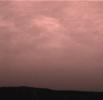 |
 |
Mars Pathfinder Imaging Team
|
 |
 |
 82382_full.jpg (16K) |
| This image was taken by the Imager for Mars Pathfinder (IMP) about one minute after sunset on Mars on Sol 21. The prominent hills dubbed "Twin Peaks" form a dark silhouette at the horizon, while the setting sun casts a pink glow over the darkening sky. The image was taken as part of a twilight study which indicates how the brightness of the sky fades with time after sunset. Scientists found that the sky stays bright for up to two hours after sunset, indicating that Martian dust extends very high into the atmosphere. |
 best_sunset.gif (78K) |
 sunset_3_v.gif (93K) |
| Sol 24 sunset showing the sun sinking into the horizon. | False color view of the sunset. |
 sunset_rt.gif (47K) |
 sunrise_stills.gif (47K) |
| A detail of the sunset showing a fan-shaped scattering of light. | Stills of the sunrise with false color. |
 sunset_three1.gif (155K) | |
 |
 |
Animation of the Martian sunset. This movie is made from nine images of the twilight following sunset over Ares Vallis. The images are enhanced in order to show the very subtle features in the haze, which are probably caused by layers that are slightly dustier than the surrounding air. The color is not the true color of the sunset -- that is shown in other images. At the beginning, the Sun is on the horizon just to the right of the frame, and it sinks during the next hour. At the time of the last image the sky is only 1% as bright as at the beginning, but the IMP can easily adapt to the darkness and return these pictures. Because there is so much dust extending high into the martian sky, the sky stays bright for more than an hour after sunset. | |
 82453_full.jpg (16K) |
 82454_full.jpg (16K) |
| Pink stratus clouds are coming from the northeast at about 15 miles per hour (6.7 meters/second) at an appoximate height of ten miles (16 kilometers) above the surface. The clouds consist of water ice condensed on reddish dust particles suspended in the atmosphere. Clouds on Mars are sometimes localized and can sometimes cover entire regions, but have not yet been observed to cover the entire planet. The image was taken by the Imager for Mars Pathfinder (IMP) on Sol 16 about forty minutes before sunrise showing areas of the eastern Martian horizon. | |
 82381_full.jpg (16K) |
 82456_full.jpg (16K) |
| This is the first color image ever taken from the surface of Mars of an overcast sky. Featured are pink stratus clouds coming from the northeast at about 15 miles per hour (6.7 meters/second) at an appoximate height of ten miles (16 kilometers) above the surface. The clouds consist of water ice condensed on reddish dust particles suspended in the atmosphere. Clouds on Mars are sometimes localized and can sometimes cover entire regions, but have not yet been observed to cover the entire planet. The image was taken about an hour and forty minutes before sunrise by the Imager for Mars Pathfinder (IMP) on Sol 16 at about ten degrees up from the eastern Martian horizon. | This is the first image ever taken from the surface of Mars of an overcast sky. Featured are stratus clouds coming from the northeast at about 15 miles per hour (6.7 meters/second) at an approximate height of ten miles (16 kilometers) above the surface. The "you are here" notation marks where Earth was situated in the sky at the time the image was taken. Scientists had hoped to see Earth in this image, but the cloudy conditions prevented a clear viewing. Similar images will be taken in the future with the hope of capturing a view of Earth. From Mars, Earth would appear as a tiny blue dot similar to how a star would appear to an earthbound observer. Pathfinders' imaging system will not be able to resolve Earths' moon. The clouds consist of water ice condensed on reddish dust particles suspended in the atmosphere. Clouds on Mars are sometimes localized and can sometimes cover entire regions, but have not yet been observed to cover the entire planet. The image was taken about an hour and forty minutes before sunrise by the Imager for Mars Pathfinder (IMP) on Sol 16 at about ten degrees up from the eastern Martian horizon. |
Return to Atmospheric and Meteorological Page